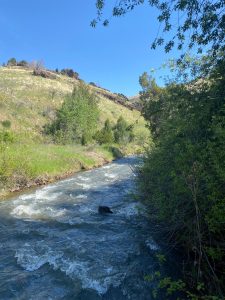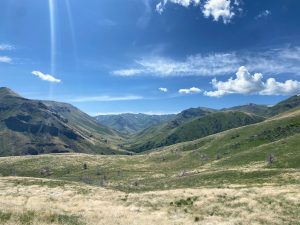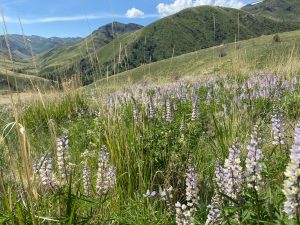 As ICL works to make the Snake River swimmable and fishable again, we must look to the tributaries of the Snake River that are similarly overused and overpolluted; these “working rivers” are microcosms of the Snake River’s larger troubles. One such tributary is Rock Creek, which dumps into the Snake River on the western edge of the city of Twin Falls. To appreciate Rock Creek in full, ICL staff adventured to its headwaters in the South Hills.
As ICL works to make the Snake River swimmable and fishable again, we must look to the tributaries of the Snake River that are similarly overused and overpolluted; these “working rivers” are microcosms of the Snake River’s larger troubles. One such tributary is Rock Creek, which dumps into the Snake River on the western edge of the city of Twin Falls. To appreciate Rock Creek in full, ICL staff adventured to its headwaters in the South Hills.
We begin our exploration of the South Hills just north of Magic Mountain, where Rock Creek runs cold and clear. The mud of spring runoff gives the creek an earthy tone, but it hardly resembles the thick, opaque ribbon of agricultural runoff that will tumble into the Snake River just over thirty miles downstream. In fact, from where we begin our hike, it’s hard to believe that this little mountain stream—surrounded by cottonwoods and pine, flitting dragonflies and butterflies—could possibly be the same that lurches through miles of farmland and trims the urban edge of Twin Falls.
Rock Creek Headwaters: the view from the rim
The day’s objective is the Rim View Trail, a gentle out-and-back that winds up the walls of the Rock Creek Canyon to the edge of the rock bluffs above. We cross Rock Creek and begin our hike, climbing slowly above the water. As the trail ascends, the Third Fork Rock Creek Canyon comes into view; the Third Fork itself hides in the riparian belly of the canyon, but the folds in the hillsides give away the zig-zag journey of the water below.

Spring has arrived in the high desert, and there’s an exuberance to the landscape; the grass is filled with flowers and teeming with bugs. Pockets of lupins dot the hillside, and we stir up their sweet, fresh scent as we make our way along the trail. Just above us, we can make out the scars of the 2020 Badger Fire, marked by swathes of charred dirt and skeletal groves of scorched trees. Three years ago, the Badger Fire cleared over 90,000 acres and threatened the habitat of South Hills-endemic Cassia Crossbill. Today, on the heels of a long and wet winter, it’s hard to imagine that the green hills around us were once, not all too long ago, bare and black.
As we travel through a patch of Aspen saplings, ICL staff Jonathan Oppenheimer springs into forager mode; surely, somewhere amid the charred soil and the humid undergrowth is a morel or two—or three, or four—with his name on it. Armed with his “lucky mushroom bag,” he sporadically disappears from the trail while the rest of us trudge on. As we climb to the canyon rim, we finally hear the joyous shout announcing that, as hoped, there is a single morel awaiting a home in Oppenheimer’s lucky mushroom bag.

Back down the canyon
We stop below a juniper for lunch and watch the vultures ride thermals above us. We’ve yet to see another person today; as far as we can tell, it’s just us, the birds, the lupins and the junipers, and a few solitary mushrooms on the trail today.
We return to the canyon floor and to Rock Creek with an uneventful stroll down the hillside. We receive one good-natured warning from a rattlesnake on the way, but we heed the message and leave him to enjoy his hidey-hole in the matted grass and bush. Thunderclouds settle in overhead, but not unlike our rattlesnake friend, they only threaten action. We mosey along without a drop of rain.
Hiking the Rim View Trail and experiencing the wild, quiet region from which Rock Creek originates was remarkable. The vibrant Rock Creek of the South Hills is a far cry from the sediment-thick, phosphorus-filled plume we know it to be; our adventure offered a look into what Rock Creek could be, with a little less use and fewer pollutants. But to make that happen, we need your help. Together we can restore the Snake River’s “working” tributaries, like Rock Creek, and defend clean water. Take Action for clean water today by telling elected officials that you want them to prioritize safe drinking water and a clean Snake River.
